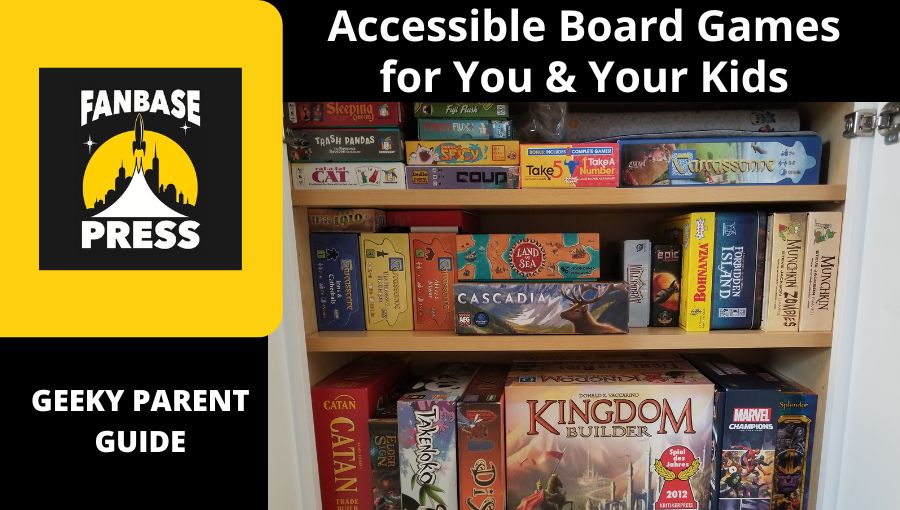If you’re looking for a fun way to connect with your kids (or significant other!), playing board games is a solid way to accomplish that goal. There are a seemingly infinite number of board games out there, and some with a higher learning curve than others, so let’s dive into a handful of games you and your kids can play with relative ease.
Over the past couple months, we have had a number of new games come into our home, including a majority of them as Christmas gifts. I’ll break down the general gameplay, rules, and mechanics, while highlighting what makes them fun. Also, I’ll wrap up with how my kids and I rank each of these games. To be clear, there aren’t any bad games on this list.
Also, if it helps, I would consider my son Marshall (age 9) an avid board gamer, while my daughter Adelaide (age 11) is an occasional gamer. I love playing whenever I get the chance.
In no particular order, let’s dive into some fun games and what they look like.
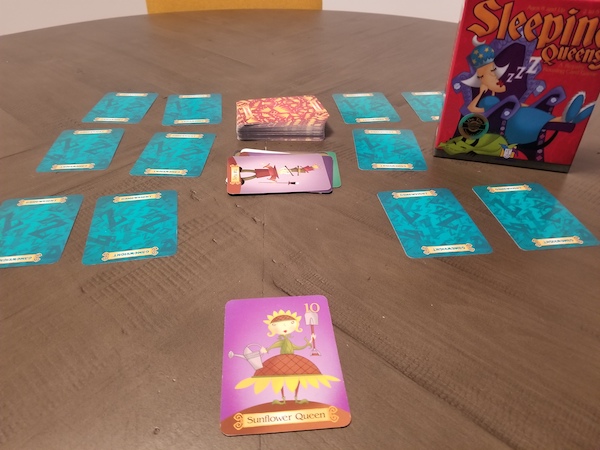
Sleeping Queens
Designer: Miranda Evarts
Publisher: Gamewright
Players: 2 – 5
Time: 20 minutes
Sleeping Queens is a card game where the goal is to collect queens by playing various types of cards. Each queen has a certain value and a player can win in a few different ways, depending on player count. If you collect a certain number of queens, reach a certain point total, or have the most points after all the queens have been collected, you win the game.
Marshall and Adelaide had already played this game previously before buying it. They really enjoy the ability to steal queens or block someone from stealing, so it’s not a surprise they did request this game for Christmas. I am interested to see how long their interest in this game continues as it is very approachable for a younger audience.
A very cool fact: This game was created by a 6-year-old! “Sleeping Queens was invented by 6-year-old Miranda Evarts, who thought up the game one night when she couldn’t fall asleep. She awoke the next morning and with help from her older sister, Madeleine, and her parents Denise and Max created this wonderfully whimsical world of napping nobles.” How cool is that?!
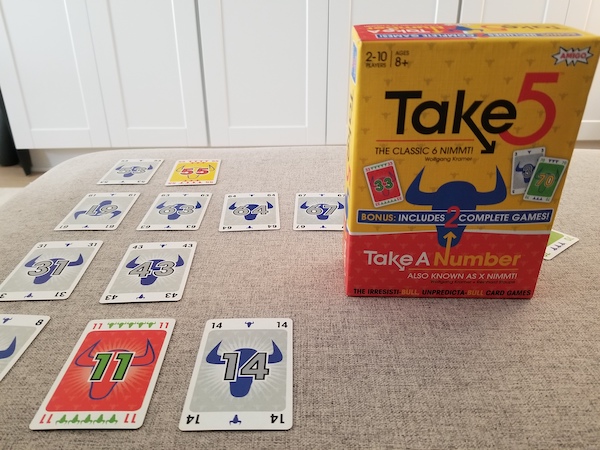
Take 5 (also known as 6 nimmt!)
Designer: Wolfgang Kramer
Publisher: Amigo Games
Players: 2 – 10
Time: 20 minutes
Take 5 can present some very wild moments – and laughter is the only possible solution once the dust has settled. Each player gets dealt 10 cards. There are then four cards placed face-up on the table making 4 rows. Then, each player must pick a card from their hand and everyone reveals simultaneously. From lowest to highest-valued card, those cards are then put into a row next to the closest number.
Once a card has 5 cards in a row, whoever places a sixth card down, they must collect that entire row of cards. What’s bad about that? Well, each card has a certain number of bull icons on it – and they count as negative points. The first person to reach more than 66 negative points triggers the end of the game. The person with the fewest negative points wins the game.
This game creates amazing moments, because I might think, “Oh, there’s one space left in that row that’s showing a 24 and I have a 26. What are the odds someone plays a 25 in front of me?” And then it happens and you’re stuck collecting an entire row of negative points. There have definitely been many fits of cackling with this game.
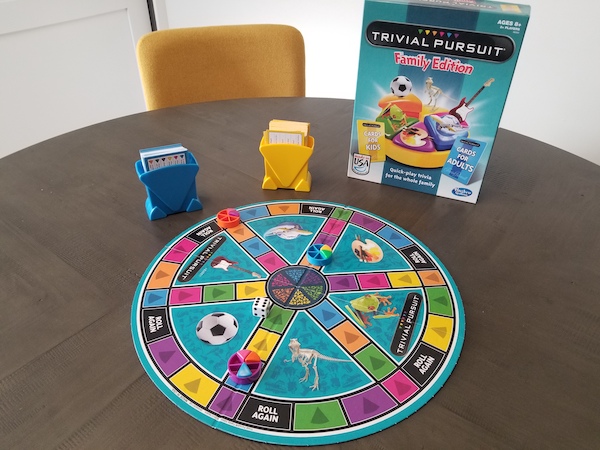
Trivial Pursuit: Family Edition
Publisher: Hasbro Gaming
Players: 2 – 4
Time: 30 – 45 minutes
Trivial Pursuit is a classic game. Roll the die, land on a spot, and then receive a question from whatever category is associated with the color you land on. There are separate decks of cards for kids and adults. And let me tell you, they aren’t all easy questions either. Easy rule set, sure, but you’ll have to know your stuff to get the answer right.
My daughter has really grown to love trivia. It’s our second (or third) trivia-style game and one of her favorites for sure. There is enough variety in categories and difficulty amongst questions to make this easy to come back to again and again. First player to fill their sphere with a colored wedge from each category, before answering one final question, wins.
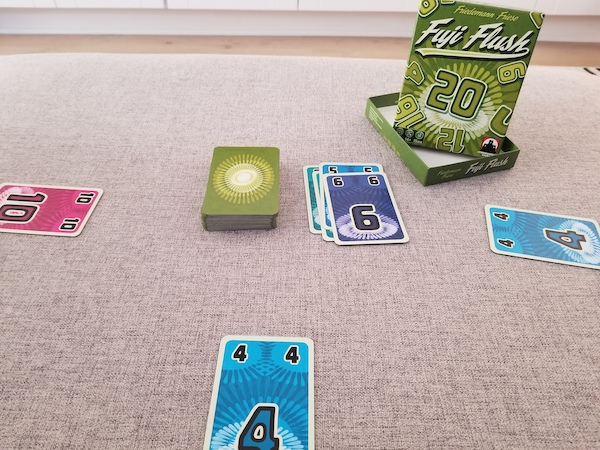
Fuji Flush
Designer: Friedemann Friese
Publisher(s): Multiple (including Stronghold Games for our copy)
Players: 3 – 8
Time: 10 – 20 minutes
This is a card game I’d heard about and instantly knew my family would enjoy it. The sole purpose of this game is to shed your hand of cards first. Each player is dealt a hand, with each card having a specific number on it. If someone plays a higher-numbered card than what you played, you flush (or discard) your card and draw a new one. If someone plays a card and no one beats it with a higher number by the time it’s their turn again, the card gets flushed, but that player does not draw a new card.
Play continues in this fashion until someone has flushed their hand of cards – and wins the game. The fun twist involved with this game happens when another player plays the same numbered card. If my wife plays a 4, and then I play a 4, our cards become an 8 and someone must beat an 8 to flush our cards. Fuji Flush is easy to learn with minimal rules, and it provides this interesting decision-making space of whether or not to work together in some instances.
Also, pay attention to how many cards everyone else has, because you might not realize your son is on his last card and play a card with the same number rather than flushing it with a higher card. What were you thinking, Travis? Also, good game, Marshall!
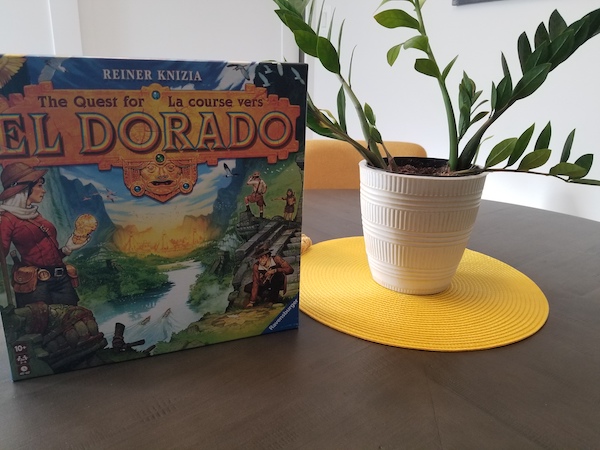

The Quest for El Dorado
Designer: Reiner Knizia
Publisher: Ravensburger
Players: 2 – 4
Time: 30 – 60 minutes
If you or anyone else in your family is looking for a racing game, then look no further! The Quest for El Dorado sets players on a board with different terrain types. Your goal is to reach the finish line before anyone else, which you accomplish by playing cards with matching terrains. Each player starts with their own deck of cards, and once you use those cards, they get discarded and you draw a new hand. The cards are also multipurpose, which means they can be used for movement or purchasing other cards.
Players will improve their hands by purchasing better cards, while also trying to cycle through cards fast enough to get to those improved cards faster. It’s also possible to trash cards from your hand, which permanently removes them from your deck. The board is module with a variety of hexes to be connected together, so it can be set up in a seemingly infinite number of different designs. This gives The Quest for El Dorado a ton of replay value, while combining a fun racing and deckbuilding game.
Where Does Each Game Land for Us?
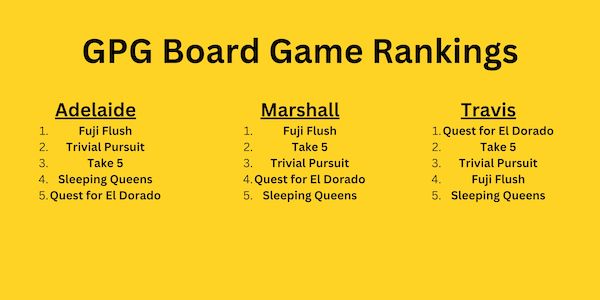
What Games Should We Cover Next?
These are just a handful of games that are quite accessible and very easy to earn and get to the table. There are a few other games I’ve gotten recently, but have not played enough times or have yet to play; such as Dune: Imperium, Fantasy Realms, Battle Line, and Sea Salt & Paper. Are there any games you would like to see covered on the Geeky Parent Guide and would like the inside scoop from me and my kiddos?
Also, what games interest you the most in the ones we’ve talked about today? Have you played any, and if so, do you have a favorite? Share your thoughts with us in the comments or head over on Facebook or Twitter and let us know there.
Until next time, happy parenting and happy geeking.

